Friction in Everyday Life: What You Need to Know

In this blog, we have tried to debunk some common myths about friction and answer some queries such as, what is friction? What are the types of friction? How it is essential for us? etc. Join us on this journey to learn more about friction.
By Topperlearning Expert 03rd Jan, 2024 | 12:53 pm
ShareIntroduction
Have you ever wondered why walking on a smooth or wet surface is difficult? Or are you unable to open a stubborn jar with a bare hand? What is the reason behind this phenomenon? The main culprit for all this is friction. So, what is friction? It is defined as the relative force that opposes the relative motion of objects in contact with each other.
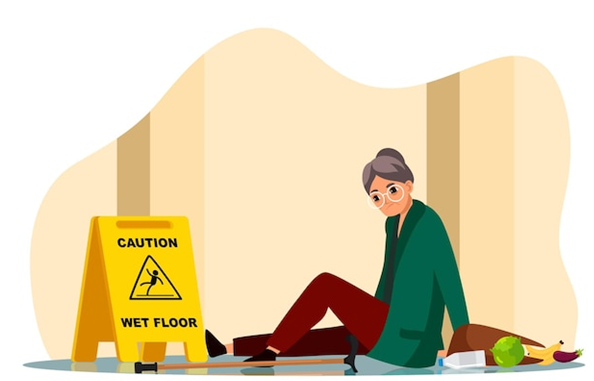
Friction is generally viewed in a negative light by most of us, but that is not entirely true. In this blog, we will try to understand what friction is and how it is essential for various phenomena that play a vital role in our daily lives.
Understanding Friction
To understand the term friction, let us perform a simple experiment using two books of some thickness. Open these books and start interleaving their pages together (Placing one page over the other), as shown in the figure below. Once you are done, try pulling them apart from their edges. What did you observe? Was it easy to separate them by applying force across their edges? If so, then why is it difficult to do so?

Now, if you touch the pages of books, it seems to be smooth, but when they are interleaved, the surface area in contact between two books increases. As a result, it becomes quite tricky to separate them due to the force of friction.
It plays a vital role in our day-to-day life, from matchsticks to driving a car or launching rockets into space. In simple terms, the force that develops at the surfaces of contact of two bodies and opposes (impedes) their relative motion is called friction force.
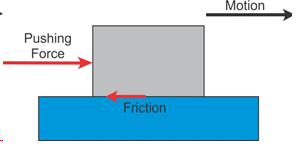
Watch this video to learn more about friction.
Types of Friction
Friction force can be classified into four types:
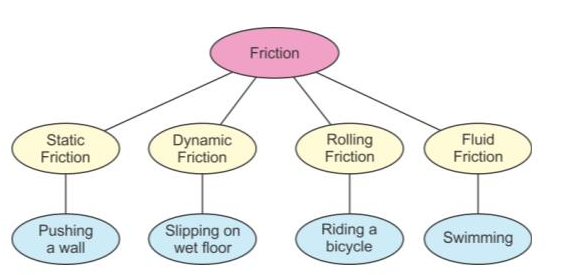
-
Static friction: The force required to overcome friction when an object starts moving from rest is the measure of static friction.
Example:

-
Sliding or dynamic friction: The force required to keep an object moving with the same speed is the measure of sliding friction.
We must note that static friction is always more significant than sliding friction for an object.
i.e., Sliding friction < Static friction
Thus, it is easier to keep an object that is already in motion moving than to move the same object from rest.
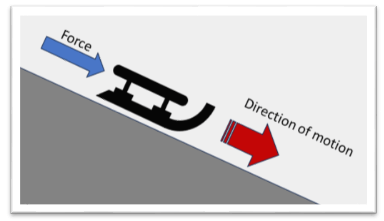
- Rolling friction: The frictional force which comes into action when an object rolls over a surface is called rolling friction.
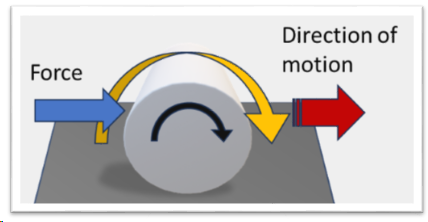
-
Fluid Friction: The frictional force exerted by fluids (i.e., gases and liquids) is called fluid friction or drag.
It depends on
1. speed with respect to fluid,
2. the shape of the object
3. the nature of the fluid.
Factors responsible
-
Nature and smoothness of surfaces:
A rough surface produces greater friction than a smoother surface. This is because of the irregularities on the surfaces of the objects in contact with it.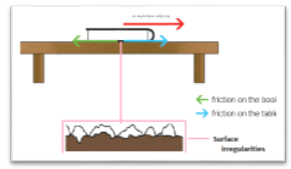
To understand this, we can conduct a thought experiment in which we are to pull a heavy box over two surfaces; one is smooth, such as a tiled surface, and the other one will be carpet. On which surface do you think we must pull harder to move the box of the same mass?

-
Forces applied between surfaces: Friction also depends on the weight of an object.
i.e., the heavier the object, the greater the friction force acting on it.
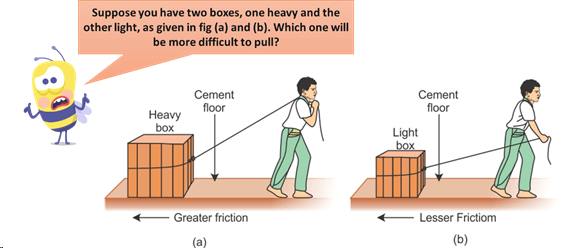
Friction: A necessary evil
Friction is an essential aspect of our daily lives, and it plays a crucial role in enabling us to perform a wide range of tasks, such as holding objects, walking, and even lighting a matchstick, which would be impossible without friction. Although friction has drawbacks, it is a necessary evil that helps us achieve our goals. By striking a balance between the advantages and disadvantages of friction, we can harness its power and make the most of it.
Now, let us understand some of the essential applications of friction in our day-to-day lives.
Can friction be helpful in certain situations?
-
Braking: A bicycle stops moving when the brake is applied. The rubber of the brake slows the motion of the wheel's rim by friction.

-
Walking: When we walk, static friction prevents our feet from slipping and helps us move forward. This is because our foot pushes on the ground, causing static friction to act in the direction of motion. Without static friction, we would slide backwards.
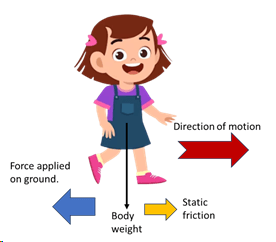
-
Friction in sports: Friction plays a vital role in every sport, from holding a bat to ice skating and swinging a ball in a particular direction. We will try to cover this in detail in our upcoming blogs, so stay tuned.
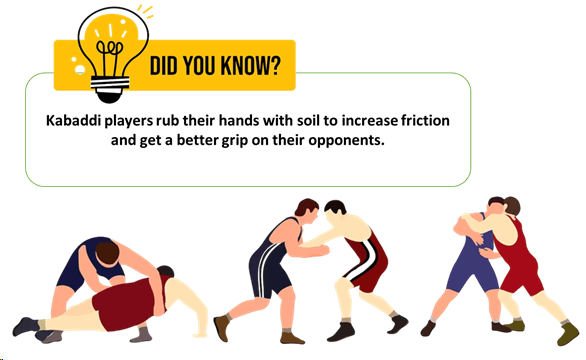
Friction as a foe
-
Moving heavy furniture around: As we discussed earlier, friction sometimes makes moving an object difficult. Now you know the reason why?

-
Wear and tear of machine: All moveable parts of the machine experience wear and tear due to friction force; as a result, they need periodic maintenance and sometimes replacement.
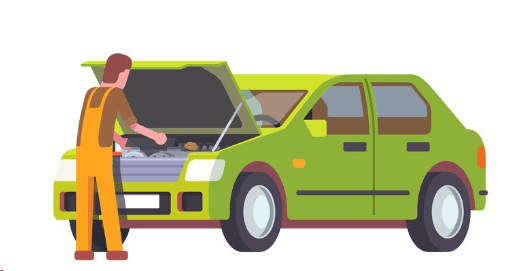
Real-life applications.
-
Use of friction in fluids: An aeroplane, as well as a speed boat, has a streamlined shape to reduce drag while moving through the medium, such as air and water, respectively.
Similarly, a parachute uses air drag to reduce the speed of falling.

-
Use of ball bearings: Ball bearing reduces friction by converting sliding to rolling friction with the help of smooth ball and lubricants.

There are many such applications of friction in our day-to-day lives, and it is essential to understand its role and importance.
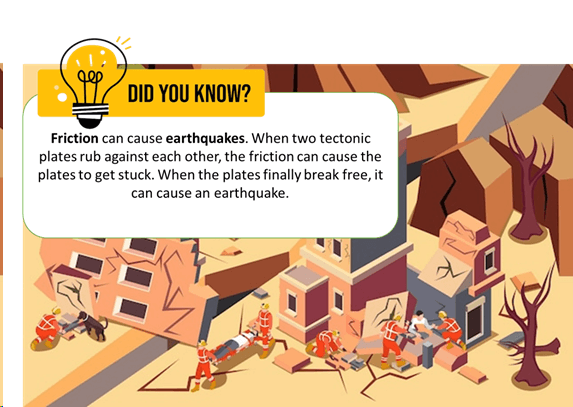
Conclusion
We hope you enjoyed reading this blog and learned something new about friction. The topic friction is not only crucial as per the CBSE class 10 syllabus but also for building a solid foundation. We believe that in this day and age, kids must know about solving real-world problems, understand technology better, and spark creativity and innovation. At Topperlearning, we want to help kids prepare for these opportunities by teaching them about concepts and how to apply them in real life according to the NEP 2020 plan.
Learn more about such topics with TopperLearning to spark curiosity among the kids. We bring you high-quality study materials like video lessons, sample papers, practice questions, textbook solutions, and more for CBSE, ICSE, Maharashtra Board, JEE and NEET to help you take your exam prep to the next level!
TopperLearning is now on WhatsApp Channels!
Click the link below to subscribe today and stay updated on current affairs, study tips, our latest offerings and more. Click here!
FAQ's
Q 1. What is friction, and how does it affect everyday life?
Ans: The force that always opposes one object's motion over another object in contact with it is called friction.
For example, when we push a heavy bag kept on the ground, there will be a force between the surfaces of two objects, which is called frictional force.
Q 2. How can we reduce friction when necessary?
Ans: Friction between two surfaces can be reduced in the following ways:
- By lubricants (i.e., grease, oil and graphite)
- By polishing the surfaces
- By converting sliding to rolling friction (Ball bearing)
Q 3. Is friction a significant factor in sports and games?
Ans: As discussed earlier, friction is crucial in almost every sport, providing the necessary grip and control for optimal performance.
Q 4. Are there ways to increase friction intentionally?
Ans: We can increase the friction between two surfaces in the following ways:
- Increasing area of contact (Just like we saw in the experiment with books)
- Use of adhesive materials (use of rubber for shoe soles and tyres.)
- Increasing the force between two surfaces
- Increasing the roughness of two surfaces
Q 5. Is friction topic important as per the class 10 physics syllabus?
Ans: Although friction topic is not part of the CBSE class 10th syllabus, it is essential to learn about it to understand its importance in our daily lives and build a solid conceptual foundation.
Watch this video to learn more about friction.
More from Education
Important Resources
- Education Franchisee opportunity
- NCERT Solution
- CBSE Class 9 Mathematics
- NCERT Solutions for class 10 Science
- Sample Papers
- CBSE Class 9 Science
- NCERT Solutions for class 10 Maths
- Revision Notes
- CBSE Class 10 Hindi
- CBSE Class 10 English
- CBSE Class 10 English
- CBSE Class 10 Social Studies
- CBSE Class 10 Science
- CBSE Class 10 Mathematics
- Career In Science After 10
- Career In Commerce After 10
- Career In Humanities/Arts After 10
- NCERT Solutions for Class 10
- NCERT Solutions for Class 11
- Business Studies Class 12 CBSE project





